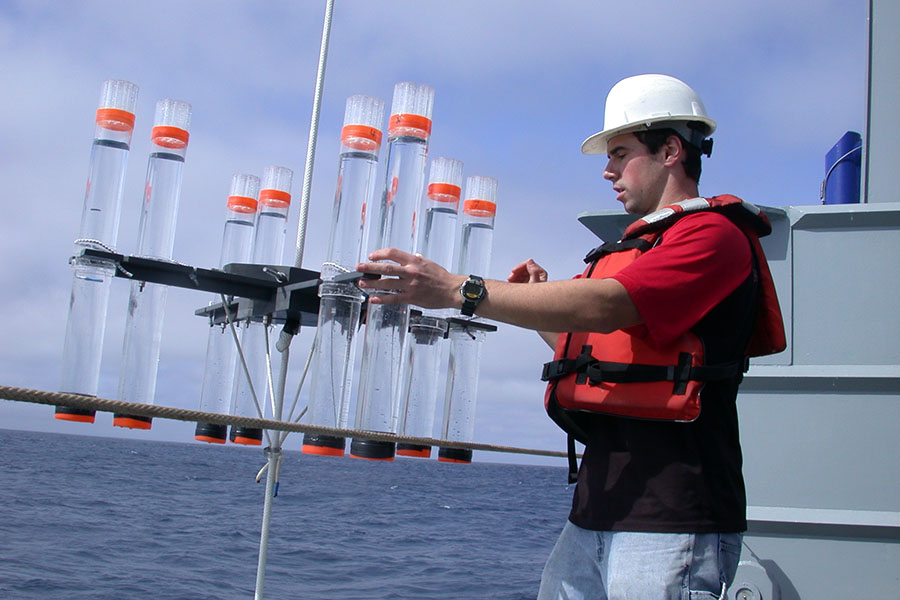
The sea is Earth’s most formidable carbon dioxide-storage machine, but mysteries still abound about the interlocking processes of that storage and the myriad organisms involved.
Now, thanks to a series of papers published in the journal Frontiers in Marine Science, researchers at Florida State University are inching toward a clearer understanding of the ocean’s carbon storage, its constituent biological players and the factors that could be limiting its efficiency.
In three studies of the biological carbon pump — the process by which carbon dioxide produced by photosynthetic algae in the surface ocean is transferred to the seafloor and stored for millennia — Associate Professor of Oceanography Mike Stukel and his collaborators found that microscopic zooplankton play critical, often underappreciated and sometimes oppositional roles in the transport and sequestration of carbon.
“These organisms contribute to the biological carbon pump by creating carbon-rich fecal pellets that sink rapidly into the ocean,” Stukel said. “However, some zooplankton also feed on sinking particles, thus decreasing the efficiency of the biological carbon pump.”
About 5-12 metric gigatons of carbon is transported yearly by the biological carbon pump — a volume similar to the amount of carbon dioxide produced by humans every year through burning fossil fuels.
However, hordes of hungry zooplankton hundreds of meters below the surface often consume carbon-rich particles sinking toward the ocean floor, interrupting that transport process.
“This prevents the carbon from being sequestered at deeper depths and ensures that it will be back in the atmosphere sooner,” Stukel said.
Most studies of the role of zooplankton in global biogeochemical cycles, Stukel said, have focused chiefly on krill and similarly common groups, with the assumption that their behavior is representative of all zooplankton in the ocean. But his study demonstrates the variety of ways these diminutive organisms can alter, and sometimes impede, the biological carbon pump.
In an investigation of two specific types of zooplankton, phaeodarians and pteropods, Stukel and his team found that these groups of sinking particle-feeding organisms may influence carbon transport just as much as more abundant suspension-feeder zooplankton like krill, which dine on floating organic matter nearer to the ocean’s surface.
“Some species have very different characteristics that give them outsized importance in marine biogeochemistry,” he said.
The regular vertical migration of zooplankton from surface to deeper waters is essential to the transport and safe sequestration of carbon in the ocean. Stukel and FSU graduate student Thomas Kelly found that these tireless travelers account for far more carbon transport than previous estimates would suggest.
Using an advanced, integrated ecosystem model, Stukel and Kelly evaluated surface-level algal production rates, biomass estimates and fish and zooplankton prey requirements. Their model showed that the metabolic demands of organisms hundreds of meters below the surface required greater migrator-delivered carbon than expected.
The upshot: Significant carbon transport from vertically migrating zooplankton was more ecologically important than anticipated.
“Most previous estimates of migration-related carbon flux have suggested that migration is only responsible for 5 to 20 percent of downward flux,” Stukel said. “However, our study suggests that previous results may have underestimated the true importance of migration, and that it may actually contribute almost half of total flux in productive coastal regions.”
Researchers have an arsenal of strategies for assessing carbon-rich particle flux in the biological carbon pump. Some of them, like drifting sediment traps, require extensive time aboard research vessels, an expense that can often be prohibitive.
Another method, called optical imaging, allows scientists to snap detailed photos of particles with underwater cameras and use profiles of the particles’ sizes to derive new understanding of their movement throughout the water column.
“Basically, theory tells us that there should be relationships between particle size and both sinking speed and carbon content,” Stukel said. “If we can measure the size and abundance of particles — and if these theoretical relationships hold — we can estimate particle flux by taking pictures of particles in the ocean.”
Stukel and FSU graduate student Christian Fender put the more cost-effective optical imaging method to the test. They found that conventional algorithms for measuring particle flux from image profiles performed particularly poorly in the California Current Ecosystem. The primary issue, Stukel said, was the failure of the algorithms to adequately account for heavier, fast-sinking zooplankton fecal pellets, which are an important component of the region’s overall particle flux.
In response to this finding, the team developed an algorithm designed to estimate flux from particle size under the specific conditions of the California Current Ecosystem. These specially tailored parameters, which foregrounded the importance of the zooplankton fecal pellets, significantly outperformed the standard algorithms.
The study showed that, in order to best capitalize on more affordable optical imaging strategies, researchers need to pay close attention to the specific environments and particles they’re investigating.
“Our results show that cameras need to quantify not only the size of the particle, but also classify what type of particle it is,” Stukel said.
The three studies produced by Stukel and his team reveal new insights into the micro-scale mechanics of one of the world’s most important carbon transport processes. In addition to highlighting the gatekeeping zooplankton that often halt the sequestration of highly carbonic particles and the historically undervalued role of plankton migrators in the biological carbon pump, the research also makes important suggestions about how to better evaluate carbon flux in variable ocean environments around the world.
Stukel said the best way to achieve a more comprehensive understanding of the biological carbon pump is to develop a deeper appreciation for the panoply of plankton that keep it pumping.
“Given their diverse roles in the biological carbon pump, it is important for scientists to not only consider how many zooplankton are in a particular region, but also to focus on the diversity and functional roles of these groups,” he said.
These studies were funded by a National Science Foundation grant to the California Current Ecosystem Long-Term Ecological Research program.




